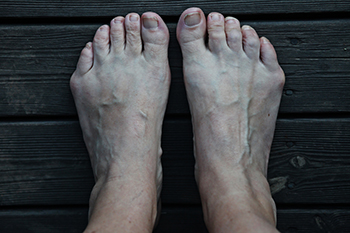What Is a Bunionette?
Tuesday, 29 June 2021 00:00 Bunions appear as a bony lump at the main joint of the big toe when the big toe turns towards the other toes. A Tailor’s bunion, or bunionette, is the same thing but occurs at the base of the little toe. Tailor’s bunions are often a result of a faulty mechanical structure. As the little toe shifts inwards, the metatarsal bone begins to stick outwards. Tailor’s bunions are often indicated by redness, swelling, and pain, and they usually become irritated by shoes that are too narrow in the toes. Patients who believe that they have a Tailor’s bunion should consult with a podiatrist for a proper treatment. Nonsurgical treatment options include shoe modifications, padding, icing, orthotics, or injection therapy. In more severe cases, a podiatrist may need to perform surgery on the bunionette.
Bunions appear as a bony lump at the main joint of the big toe when the big toe turns towards the other toes. A Tailor’s bunion, or bunionette, is the same thing but occurs at the base of the little toe. Tailor’s bunions are often a result of a faulty mechanical structure. As the little toe shifts inwards, the metatarsal bone begins to stick outwards. Tailor’s bunions are often indicated by redness, swelling, and pain, and they usually become irritated by shoes that are too narrow in the toes. Patients who believe that they have a Tailor’s bunion should consult with a podiatrist for a proper treatment. Nonsurgical treatment options include shoe modifications, padding, icing, orthotics, or injection therapy. In more severe cases, a podiatrist may need to perform surgery on the bunionette.
If you are suffering from bunion pain, contact Dr. Kirk Sherris of Liberty Bay Foot & Ankle. Our doctor can provide the care you need to keep you pain-free and on your feet.
What Is a Bunion?
Bunions are painful bony bumps that usually develop on the inside of the foot at the joint of the big toe. As the deformity increases over time, it may become painful to walk and wear shoes. Women are more likely to exacerbate existing bunions since they often wear tight, narrow shoes that shift their toes together. Bunion pain can be relieved by wearing wider shoes with enough room for the toes.
Causes
- Genetics – some people inherit feet that are more prone to bunion development
- Inflammatory Conditions - rheumatoid arthritis and polio may cause bunion development
Symptoms
- Redness and inflammation
- Pain and tenderness
- Callus or corns on the bump
- Restricted motion in the big toe
In order to diagnose your bunion, your podiatrist may ask about your medical history, symptoms, and general health. Your doctor might also order an x-ray to take a closer look at your feet. Nonsurgical treatment options include orthotics, padding, icing, changes in footwear, and medication. If nonsurgical treatments don’t alleviate your bunion pain, surgery may be necessary.
If you have any questions, please feel free to contact our office located in Poulsbo, WA . We offer the newest diagnostic and treatment technologies for all your foot care needs.







